The rubber didn’t hit the road.
So it was with the endangered 1942 season, buffeted by the winds of war that thrust San Diego to the forefront of the defense effort.
Gasoline rationing shortly would go from volunteered to mandatory. Night football was out. So was travel.
The long-distance conference call became a popular means of communication in the CIF.
San Diego school officials were thinking long and hard and worried.
John Aseltine’s concern was magnified when he returned from the summer school break. The San Diego High principal was greeted by telephone messages from principals at Compton and Alhambra.
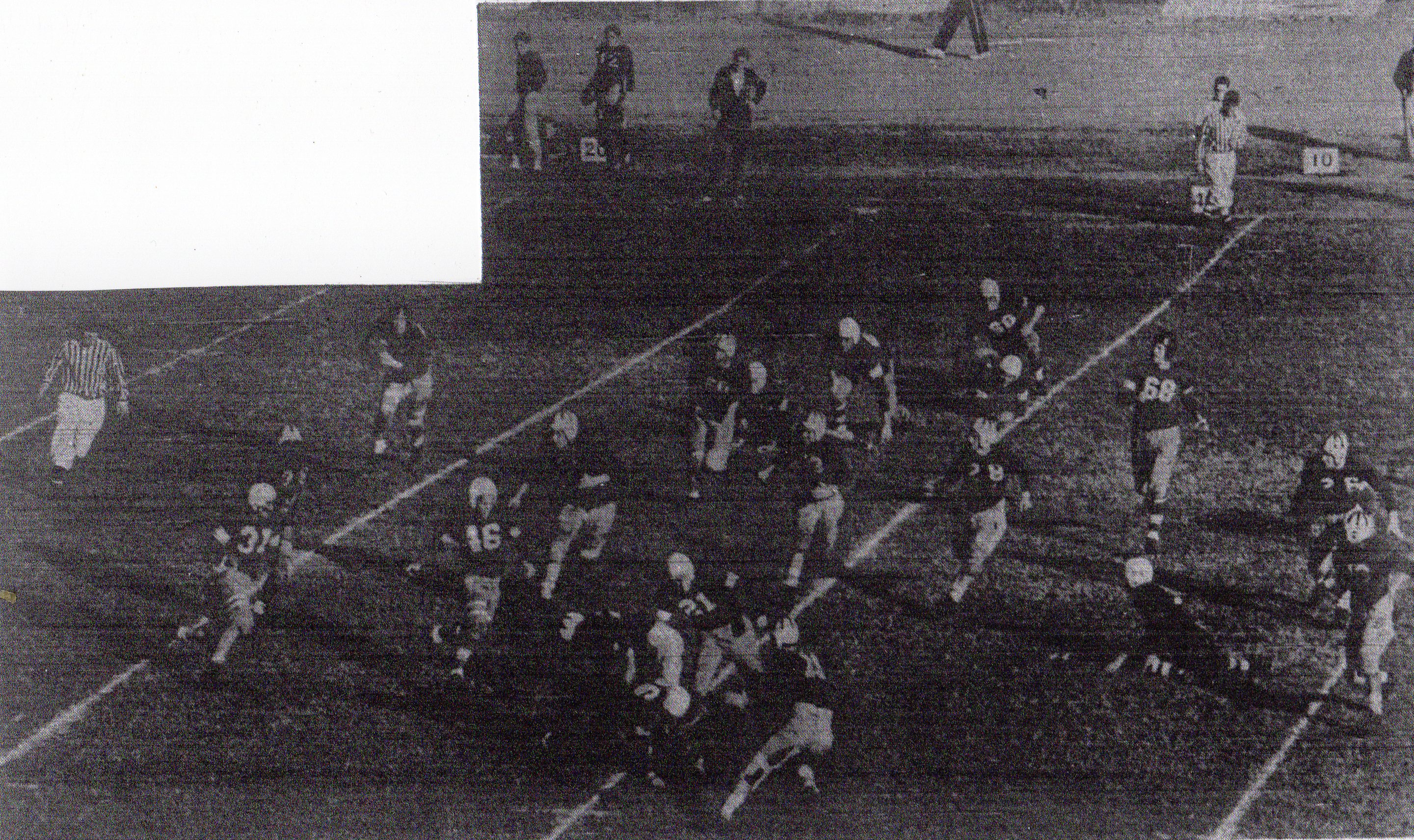
Across town at Hoover, principal Floyd Johnson was alerted to a call from the Pasadena Bullpups.
The three Northern schools, located at least 120 miles away and members with the Hilltoppers and Cardinals in the 17-team Major Conference, were candid with their San Diego colleagues.
They wanted out of scheduled road games. As the days passed so did other Los Angeles-area clubs. Uncle Sam had spoken.
San Diego and Hoover, the far South links of the league, suddenly were on the outside looking in.
Travel, always an annoying fact of life for teams in the “Border Town”, was now a problem that could not be overcome.
A shortage of fuel did not exist, according to “Mandatory Gas Rationing…lots of Whining”, in a historic review of 1942.
America had plenty of gas, but there was a shortage of rubber.
Defense plants in San Diego and elsewhere were badly in need of the substance. Imports had “slowed to a trickle”, since many traditional sources had fallen under Japanese control.
Jumpy and cautious after the Pearl Harbor attack, the government also enacted “dim-outs,” which virtually banned after-dark illumination. San Diego and the numerous coastal communities on U.S. 101 from Mexico to Canada were considered vulnerable to Japanese air raids.
Backyard bomb shelters were being dug everywhere.
METRO TO RESCUE
Relief for the traditional powers would come from their so-called “county cousins” and “little brothers” in the city.
The Metropolitan League, composed of the city’s Point Loma and La Jolla and the County’s Sweetwater, Grossmont, Coronado, Oceanside, and Escondido, invited Hoover and San Diego to join their league.
With a caveat:
Hoover and San Diego would be asked to split their squads in order to bring the others more competitively in line with the big schools.
Coaches and administrators passed the proposal in a meeting at San Diego State that preceded the San Diego County Football Officials’ Association first gathering of the season.
The Metro went from a seven-team conference to one of 11 teams, including the San Diego Blues and San Diego Whites and Hoover Reds and Hoover Whites.
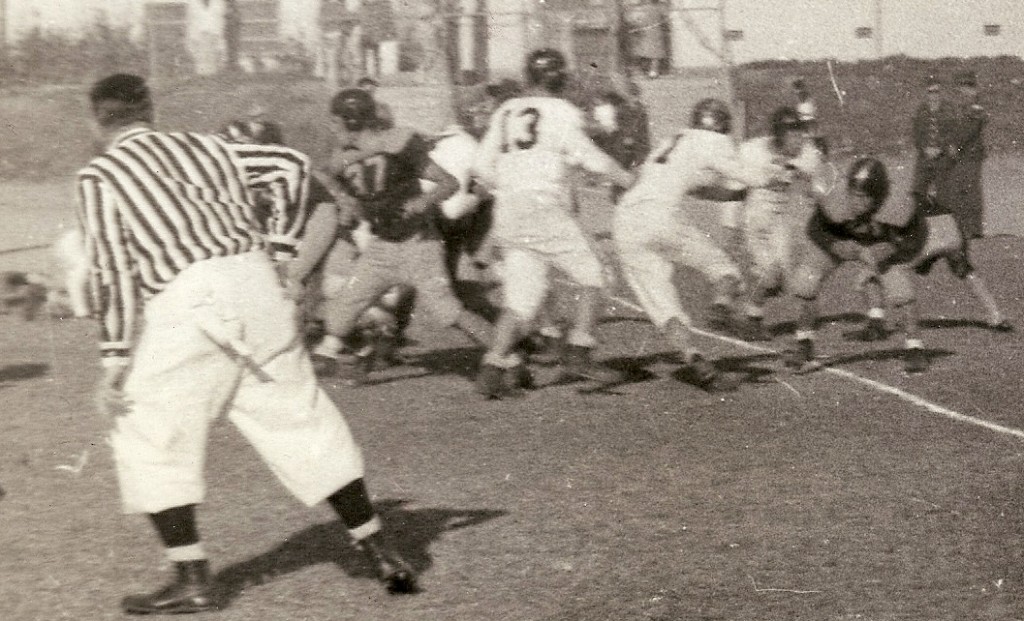
San Diego and Hoover divided their teams in a “choose-up” ceremony officiated by Sweetwater athletic director Vance Clymer. Two leading players at each school selected players for their teams with alternate picks.
The White and Blue San Diego squads became known as the Cavemen and Hillers. Hoover stayed with Whites and Reds.
City schools principals released a statement that said the proposed circuit was being accepted in light of a wartime measure and it was their hope to cooperate with the war effort to the extent of conserving rubber and gasoline and relieving traffic on the highways.
Instead of three-hour-plus runs to the North, Hoover and San Diego came into line with the others. The longest trip now would be an occasional 40-to-50 mile, mid-day jaunt, usually when Grossmont or Sweetwater played Oceanside or Escondido.
The Southern League, with Vista, San Dieguito, Army-Navy, and Ramona, shared little travel. League members Brown Military and St. Augustine, whose games did not count in the standings, played all their games on the road.
The Southern League’s breathing was labored. Except for the Saints, teams played no more than 5 games.
Travel would be reduced even more in the future.
LESS GAS, MORE RUBBER
The best way to conserve rubber was to make it more difficult for people to use their automobiles. And the best way to do that was to limit the amount of gasoline purchased.
Americans soon were introduced to the ration card, which had to be presented on every trip to the filling station.
Class A drivers were allowed only 3 gallons a week. Class B drivers (factory workers, traveling salesmen) were allowed 8 gallons a week.
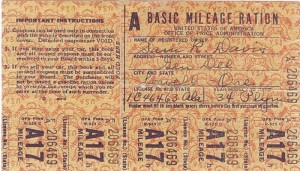
Classes C, T and X were not subject to restriction. Those classes included war workers, police, doctors, letter carriers, truck drivers, politicians, and other “important people”.
WHOA, NELLIE!
The Cavemen came out of the “draft” with the best player, quarterback Nelson Manuel, who topped all scorers with 86 points (14 touchdowns, 2 PAT) and led his squad to an 8-0-1 record.
One of Manuel’s teammates was tackle George Schutte, future USC lineman, longtime coach and instructor at San Diego City College, and legendary football game official.
Schutte also has a place in USC history. His outstanding block sprung a Trojans runner for a touchdown in USC’s mighty challenge to unbeaten, No. 1-ranked Notre Dame in 1948.
Before 100,571 fans in the Los Angeles Coliseum, underdog USC led Notre Dame, 14-7, until an 82-yard kickoff return and pass interference penalty positioned the Irish to tie the game with 35 seconds remaining and extend their unbeaten streak to 28 games.
MANUEL THE FIRST?
Evening Tribune writer Bud Maloney, years later, suggested that Nelson Manuel may have been the first black T-formation quarterback.
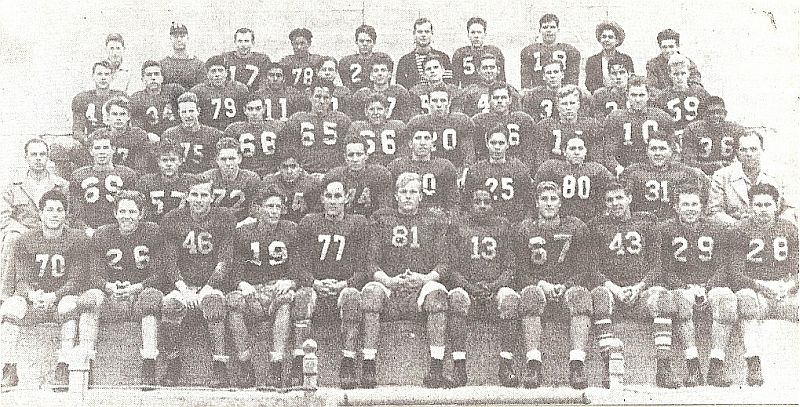
The T was introduced in 1940 by Stanford coach Clark Shaughnessy, whose team upset Nebraska 21-13 in the 1941 Rose Bowl.
San Diego’s Joe Beerkle became a disciple and was among the first high school coaches to install the T. Beerkle positioned the athletic and savvy Manuel behind the center.
CAVEMEN DOMINATE CARNIVAL
With Manuel passing for one touchdown and running for another, the Cavemen led the San Diego and La Jolla aggregations to a 21-7 victory over Hoover and Point Loma in the fifth annual City Schools carnival, with proceeds from the crowd of 8,000 going to the Red Cross.
Beerkle and Hoover coach Raleigh Holt stayed with their original plans not to combine squads. The Hillers and Hoover Reds were scoreless in the fourth quarter.
WHAT ABOUT THE BIG GAME?
There still would be the 10th annual San Diego-Hoover game for city bragging rights. The split squads would come together as one for a single game after the Metropolitan League season.
That the San Diego varsity defeated the Hoover varsity, 20-6, before about 8,000 in Balboa Stadium was no surprise.
In the season’s first “big game”, the Cavemen (5-0-1) met the Reds (5-0-1) in what the downtown media described as having “the earmarks of a real grid titanic.”
The visiting Cavemen made it no contest, winning, 41-13. Nelson Manuel threw touchdown passes to Bill Nevins (2) and Jim Wallace and finished the day with touchdowns on runs of one and nine yards.
The Cavemen and Hillers posted a 3-0-1 record against the Whites and Reds, the Cavemen earning the championship with a 7-0-1 league record. The Reds were second at 6-1-1.
Operating under the new league setup an additional, “minor division” title was awarded to a pre-war Metropolitan League member, the nod going to Point Loma, which was 6-1-2 and third overall.
Point Loma clinched the title with a 26-6 victory over La Jolla as Larry Purdy threw two touchdown passes to Ed Klosterman and ran for another.
It was a somewhat pyrrhic victory for the Pointers, whose head coach, Bill Bailey, was leaving and moving downtown to become head coach at San Diego in 1943.
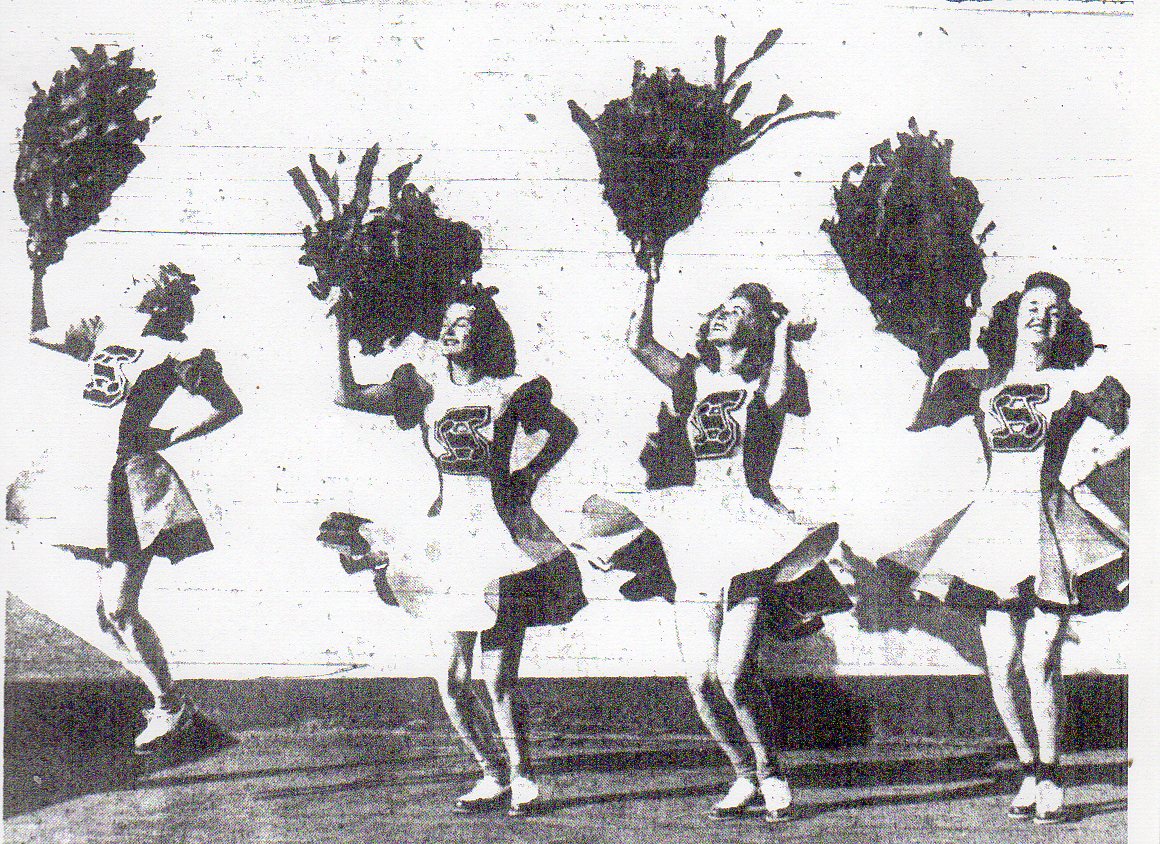
FIELD GOALS, ANYONE?
Until the soccer-style kicker emerged in the early 1960s, San Diego teams would go years without even attempting field goals. Not this season:
–Carl Kruger, Coronado, 35 yards, in 6-3 loss to Hoover Reds.
–Neal Black, San Diego, 31 yards in San Diego Hillers’ 17-6 win over St. Augustine.
–Ted Smith, Grossmont, 33 yards with five minutes remaining for difference in Grossmont’s 9-6 victory over San Diego Hillers.
–Don Sparling, Grossmont, 20 yards in 9-7 win over Grossmont.
SIGNS OF THE TIMES
Sailor Richard Thornbrue, 22, of the Naval Air Station lived a red-letter day on Nov. 20, 1942.
Thornbrue, whose duties included administering “boots” (recruits) their haircuts, filed for a marriage license with Bernice Hendrickson, 19.
Earlier in the day the tonsorial specialist said he “nearly passed out” when apprentice seaman Henry Fonda took a seat on Thorngrue’s barber’s chair.
Fonda’s wavy locks soon were on the shop floor. “He got a regulation cut, same as the other recruits,” said Thorngrue of the award-winning actor. “There wasn’t much hair left when I finished.”
THEY’RE CALLED KEY CANS
Every public school room in San Diego was equipped with a “key kan” for collection of discarded keys which contained metals necessary to the war effort.
Old keys included copper, nickel, and zinc. Proceeds from sale of the metal would go to the United Service Organization.
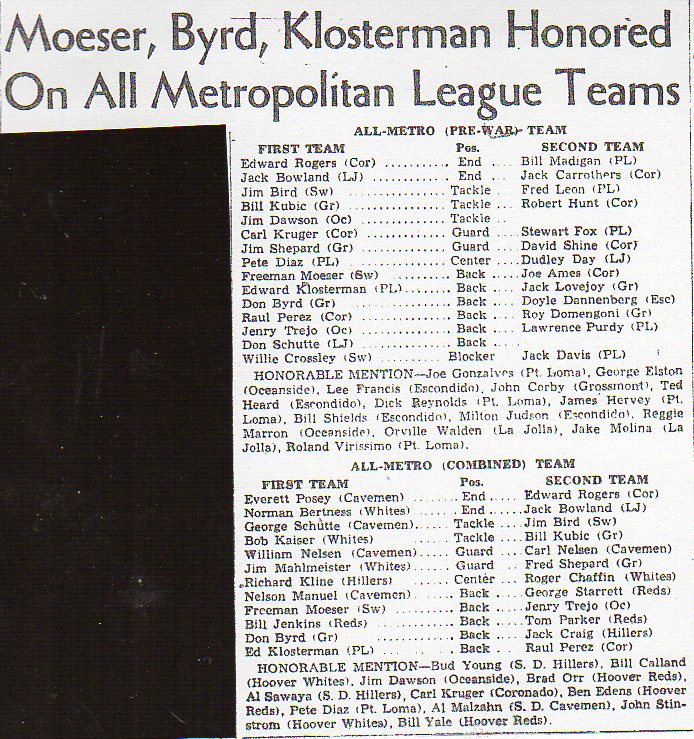
TRUE GRID
Because of the war the Southern League’s Fallbrook High, located near the Camp Pendleton Marine Base, did not field a team and would not be back on the gridiron until 1944…Halfback Tommy Parker and guard Ben Edens were among Hoover’s key players and later made their marks as coaches, “Tom” at Sweetwater from 1954-60, “Bennie” at Point Loma from 1955-1997…it was a fine moment in Jack Mashin’s long coaching career at Grossmont when only 14 Foothillers went out to battle the powerful San Diego Cavemen but came away with a 13-13 tie at Grossmont… …not much offense in the Hoover-San Diego varsity game, the Cavers gaining 141 yards to the Cardinals’ 64…San Diego’s Jim Wallace combined with Manuel on a reverse and hauled 54 yards for a punt return touchdown…Manuel scored twice on runs of 20 and 7 yards…Tony Gerache ran 95 yards for a touchdown as the Hillers defeated Oceanside 21-7…end Fred Gallup of Escondido, tackle Bob Kaiser of Hoover, guard Carl Kruger of Coronado, and quarterback Nelson Manuel of San Diego earned all-Southern California third-team honors…local football coaches who responded in the spring to a call from Uncle Sam: Charlie Wilson, Point Loma; Marvin Clark, La Jolla; Pete Walker, Hoover….
.

Hi, Rick,
Just saw your website in this morning’s paper. Glad I found it. Merry Christmas.
Allan: Thanks for writing. I’ll be writing some late’fifties stuff that I’m sure will bring back memories.
Merry Christmas.